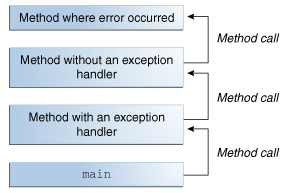Learning Resources
Exceptions
What Is an Exception?
The term exception is shorthand for the phrase "exceptional event."
Definition:
An exception is an event, which occurs during the execution of a program, that disrupts the normal flow of the program's instructions.
When an error occurs within a method, the method creates an object and hands it off to the runtime system. The object, called an exception object, contains information about the error, including its type and the state of the program when the error occurred. Creating an exception object and handing it to the runtime system is called throwing an exception.
After a method throws an exception, the runtime system attempts to find something to handle it. The set of possible "somethings" to handle the exception is the ordered list of methods that had been called to get to the method where the error occurred. The list of methods is known as the call stack (see the next figure).

The call stack.
The runtime system searches the call stack for a method that contains a block of code that can handle the exception. This block of code is called an exception handler. The search begins with the method in which the error occurred and proceeds through the call stack in the reverse order in which the methods were called. When an appropriate handler is found, the runtime system passes the exception to the handler. An exception handler is considered appropriate if the type of the exception object thrown matches the type that can be handled by the handler.
The exception handler chosen is said to catch the exception. If the runtime system exhaustively searches all the methods on the call stack without finding an appropriate exception handler, as shown in the next figure, the runtime system (and, consequently, the program) terminates.

Searching the call stack for the exception handler.
Using exceptions to manage errors has some advantages over traditional error-management techniques. You can learn more in the Advantages of Exceptions section.
The Catch or Specify Requirement
Valid Java programming language code must honor the Catch or Specify Requirement. This means that code that might throw certain exceptions must be enclosed by either of the following:
-
A
trystatement that catches the exception. Thetrymust provide a handler for the exception, as described in Catching and Handling Exceptions. -
A method that specifies that it can throw the exception. The method must provide a
throwsclause that lists the exception, as described in Specifying the Exceptions Thrown by a Method.
Code that fails to honor the Catch or Specify Requirement will not compile.
Not all exceptions are subject to the Catch or Specify Requirement. To understand why, we need to look at the three basic categories of exceptions, only one of which is subject to the Requirement.
The Three Kinds of Exceptions
The first kind of exception is the checked exception. These are exceptional conditions that a well-written application should anticipate and recover from. For example, suppose an application prompts a user for an input file name, then opens the file by passing the name to the constructor for java.io.FileReader. Normally, the user provides the name of an existing, readable file, so the construction of the FileReaderobject succeeds, and the execution of the application proceeds normally. But sometimes the user supplies the name of a nonexistent file, and the constructor throws java.io.FileNotFoundException. A well-written program will catch this exception and notify the user of the mistake, possibly prompting for a corrected file name.
Checked exceptions are subject to the Catch or Specify Requirement. All exceptions are checked exceptions, except for those indicated by Error, RuntimeException, and their subclasses.
The second kind of exception is the error. These are exceptional conditions that are external to the application, and that the application usually cannot anticipate or recover from. For example, suppose that an application successfully opens a file for input, but is unable to read the file because of a hardware or system malfunction. The unsuccessful read will throw java.io.IOError. An application might choose to catch this exception, in order to notify the user of the problem — but it also might make sense for the program to print a stack trace and exit.
Errors are not subject to the Catch or Specify Requirement. Errors are those exceptions indicated by Errorand its subclasses.
The third kind of exception is the runtime exception. These are exceptional conditions that are internal to the application, and that the application usually cannot anticipate or recover from. These usually indicate programming bugs, such as logic errors or improper use of an API. For example, consider the application described previously that passes a file name to the constructor for FileReader. If a logic error causes a nullto be passed to the constructor, the constructor will throw NullPointerException. The application can catch this exception, but it probably makes more sense to eliminate the bug that caused the exception to occur.
Runtime exceptions are not subject to the Catch or Specify Requirement. Runtime exceptions are those indicated by RuntimeExceptionand its subclasses.
Errors and runtime exceptions are collectively known as unchecked exceptions.
Bypassing Catch or Specify
Some programmers consider the Catch or Specify Requirement a serious flaw in the exception mechanism and bypass it by using unchecked exceptions in place of checked exceptions. In general, this is not recommended. The section Unchecked Exceptions — The Controversy talks about when it is appropriate to use unchecked exceptions.

